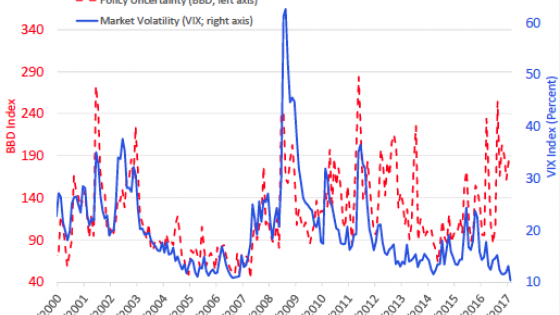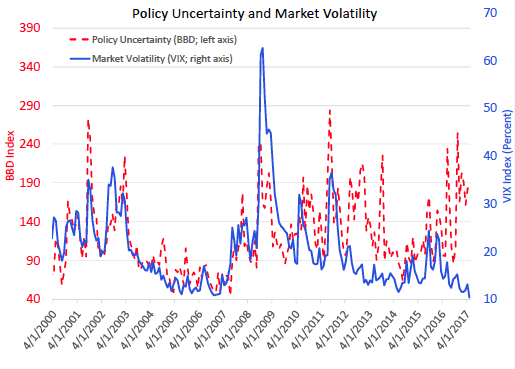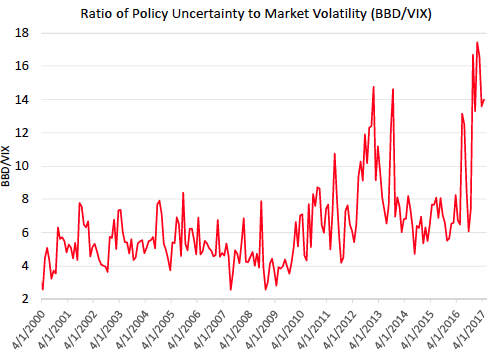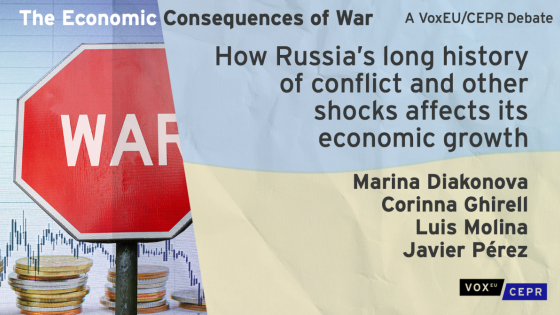In the first few months of 2017, the coexistence of high policy uncertainty and low stock market volatility has puzzled market observers. On the one hand, the index of policy uncertainty (Baker et al. 2016) has been far above its long-run mean. This is not surprising given the large uncertainty about the future policies of the new US administration. On the other hand, the Chicago Board Options Exchange Volatility Index (VIX) of implied market volatility has been testing its historical lows.
Aren’t these two phenomena contradictory? Isn’t market volatility supposed to be high when policy uncertainty is high?
Not necessarily. True, our own theory (Pastor and Veronesi 2013) implies that volatility and uncertainty should move together. But that result assumes that the precision of political signals is constant over time. In contrast, we argue here that political signals have become less precise in recent months, especially after the November 2016 election.
The puzzle
Figure 1 plots the Baker-Bloom-Davis index of policy uncertainty along with the VIX index from January 2000 through the present. The news-based Baker-Bloom-Davis index is a monthly series based on newspaper coverage of economic policy uncertainty. The VIX index measures option-implied market volatility for the Standard and Poor’s (S&P) 500 index over the following 30 days. We compute monthly values of the VIX by averaging daily closing values within the month.
Figure 1 Policy uncertainty and market volatility, January 2000-present
Shortly before the US presidential election on 8 November 2016, the VIX rose to the above-average level of 23. The elevated VIX level before the election makes sense given the uncertainty associated with the election outcome (Kelly et al. 2016). But since the election, the VIX has been unusually low. It has spent most of the past six months in the narrow range of 10 to 14. Six months after the election, on 8 May 2017, the VIX closed at 9.77, its lowest level since 1993.
In contrast, the Baker-Bloom-Davis index of policy uncertainty has been very high since the election. During the election month, in November 2016, the index rose to 254, the third-highest level in its 32-year history. Over each of the following five months, the index stayed above the level of 160, significantly exceeding its long-run historical average of 110.
These opposite post-election patterns in volatility and uncertainty are also apparent from Figure 2, which plots the ratio of the Baker-Bloom-Davis index to the VIX. Since the US presidential election, this ratio has more than doubled, and it has been higher than ever before. To understand this puzzling combination of high policy uncertainty and low market volatility, we turn to the theory that links the two concepts.
Figure 2 Ratio of policy uncertainty to market volatility, January 2000-present
The theory
The theoretical guidance comes from our own prior work (Pastor and Veronesi 2012, 2013). Our 2013 paper develops the first general equilibrium model in which stock prices respond to political news. The model formalises the idea that when politicians speak, markets respond.
Political news arrives in the form of political signals that are informative about what the government will do in the future. Political signals are observed by rational investors who use them to update their beliefs about the government’s future policy decisions. Stock prices respond to political signals. This response is stronger when political uncertainty – uncertainty about future government actions – is larger. The model thus predicts high market volatility during periods of high political uncertainty.
The precision of political signals
Specifically, our model implies that market volatility is an increasing function of the product of political uncertainty and signal precision:
Market Volatility = f([Political Uncertainty] x [Precision of Political Signals])
For simplicity, the model takes the precision of political signals to be time-invariant. As a result, higher political uncertainty implies higher market volatility.
But what if political signals are no longer as precise as they used to be? The equation shows that if signal precision is low, market volatility can be low even if political uncertainty is high. Weak signals lead to small updates in investors’ beliefs, resulting in low volatility.
In the data, market volatility is strongly positively related to political uncertainty. Using the Baker-Bloom-Davis index to proxy for political uncertainty and the VIX for volatility, we find strong co-movement: the correlation between the two indices since January 2000 is 48%.
But the co-movement between the Baker-Bloom-Davis index and the VIX has weakened significantly in recent months. For example, over the past 12 months (May 2016 through April 2017), the correlation has been only 16%. In the context of our model, this result can be rationalised by less precise political signals.
Plenty of signals…
Ever since the presidential election six months ago, investors have been flooded with political news. Besides numerous government appointments and dismissals, the Trump administration has made many pronouncements on potential reforms as well as foreign policy.
These pronouncements represent political signals that stock prices should be responding to, leading to extra volatility. Yet the response has been modest, suggesting that the signals are weak.
… with low precision
The political signals coming from the new administration have been difficult for investors to interpret. The signals have been full of reversals and contradictions. One day NATO is obsolete, another day it is not. One day China is a currency manipulator, another day it is not. One day Donald Trump has a relationship with Vladimir Putin, another day he does not. One day Janet Yellen is most likely to be replaced as the Federal Reserve Chair, another day she is not. The story of the FBI director, James Comey, includes more than one reversal. These reversals have been documented by The Washington Post Fact Checker and elsewhere.
The difficulty in interpreting the White House communication is amplified by the questionable veracity of some of its claims. Perhaps the most famous is the claim that Donald Trump had a larger inauguration crowd than President Obama, despite clear photographic evidence to the contrary. Economists also smile when they hear that the phrase ‘prime the pump’ was invented by Donald Trump. The Washington Post Fact Checker claims, ”As of Trump’s 100th day, we counted 492 false or misleading claims”. When investors try to interpret Trump’s pronouncements, they can be forgiven for being uncertain whether he is serious or just “playing to people’s fantasies”, as he suggested in The Art of the Deal (Trump and Schwartz 2015).
To be clear, we are not judging President Trump or his administration. We are making a simpler point. We argue that the contradictory nature of the political signals in 2017 has reduced their informativeness. Political news is noisier than it used to be. Investors are becoming skeptical that politicians’ pronouncements have much to do with their future policy actions. Markets continue listening to politicians, but they pay less attention than they used to. The result has been a weaker link between uncertainty and volatility in early 2017.
But do not bet on this link remaining weak forever. Sooner or later, political signals will regain their informativeness. Stronger signals might emerge from a different source, such as Congress or a different president. Next time you see the VIX index go up sharply, check out the policy uncertainty index. We predict it will be up as well.
Authors' note: We thank William Cassidy for helpful comments.
References
Baker, S R, N Bloom and S J Davis (2016), “Measuring economic policy uncertainty”, Quarterly Journal of Economics 131: 1593-1636.
Kelly, B, L Pastor and P Veronesi (2016), “The price of political uncertainty: Theory and evidence from the option market”, Journal of Finance 71: 2417-480.
Pastor, L and P Veronesi (2012), “Uncertainty about government policy and stock prices”, Journal of Finance 67: 1219-1264.
Pastor, L and P Veronesi (2013), “Political uncertainty and risk premia”, Journal of Financial Economics 110: 520-545.
Trump, D J and T Schwartz (2009), Trump: The art of the deal, New York: Ballantine Books.





